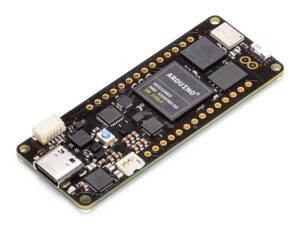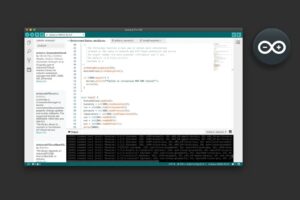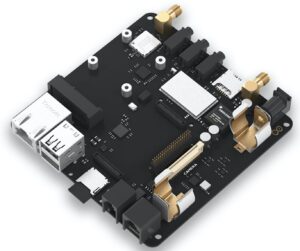The new Arduino Portenta H7 development board will be available in the coming week. We thus sat down with Dario Pennisi, hardware development manager at Arduino, to get a deep dive into the spirit behind the hardware. The Portenta H7 is highly symbolic because it’s Arduino’s first official foray into industrial MCU boards, which is why, among many other reasons, the company chose an STM32H747XI microcontroller with two cores: a Cortex-M7 and a Cortex-M4. Since the device is capable of handling temperatures as low as -40ºC and as high as +85ºC, the board can thrive under harsh conditions and offer a robust environment for professionals. And to truly embrace the needs of these developers, Arduino is also announcing the availability of its Arduino Pro IDE beta.
Portenta H7, A New Hardware Philosophy

The Portenta H7 is the first MCU board with a DisplayPort output over USB Type-C. It also includes a Wi-Fi and Bluetooth module with an on-board ceramic antenna, an Ethernet port, 8 MB of SDRAM, and 16 MB of Quad SPI Flash. Additionally, Arduino is also offering, for the first time, the ability to customize some aspects of the board, as long as companies order at least a thousand units. For instance, engineers can select up to 64 MB of RAM, up to 128 MB of Flash, and decide whether to get the Wireless module, Ethernet connector, or high-speed USB port and choose if it will carry a DisplayPort signal. Developers can thus start with the default platform to begin writing their code, then enjoy a new level of flexibility on a board that will only contain the features they need.
As Dario explained, the idea for the Portenta H7 board came about a year and a half ago. At the time, Arduino was considering an MCU with only a Cortex-M4 and a much more modular approach with stacks of boards. However, as he told us:
“Modularity becomes a weakness in an industrial setting because it vastly increases the price. We wanted flexibility and robustness while also making the board accessible, which is also why we settled on the STM32H7 after looking at MCUs from a wide range of vendors.”Indeed, beyond the presence of two cores, the STM32H747XI supports two CAN-FD interfaces, as well as UART, SPI, I2S, and I2C peripherals, which will help engineers tailor their system. Arduino also included a programmable power management IC to power a wide range of external boards from 1.8 V to 3.3 V.
Portenta H7: A Familiar Arduino Ecosystem With an ST Flare

Portenta H7 is compelling because its industrial hardware takes advantage of the Arduino ecosystem. It means that whether developers are more comfortable with a low-level programming language such as C, or higher-level paradigms, like microPython or Javascript, they can still benefit from all the features that the new board offers. Creating a motor control application or taking advantage of a sensor board can often be as simple as calling a few APIs, and the Arduino community still stands as one of the most supportive and comprehensive in the IoT world. Arduino Pro IDE builds on this initiative to offer a debugging tool, third-party plugin support, and a new interface for larger projects that will make it more relevant to industrial applications. Arduino Pro IDE beta is available now, and the final version should arrive during the second half of this year.
Beyond the hardware, using a board with an STM32 microcontroller means that developers also get access to our open-source firmware, as well as our libraries and STM32Cube expansion software, to jumpstart their platform. For instance, engineers could look at the way our source code takes advantage of the Chrom-ART graphical accelerator present in our MCU to optimize a video player or a user interface. Another scenario could conceive of coders using our libraries to implement beamforming, a technique that processes sound signals to eliminate ambient noise better and focus on a particular source. Users could also take advantage of machine learning on the Portenta H7 by either running TensorFlow Lite or use STM32Cube.AI to convert a pre-existing neural network into an optimized code for STM32 MCUs. Arduino, a member of the ST Partner Program, will also offer Arduino IoT Cloud and Arduino CLI to facilitate development operations.
Bridging the World of Makers and the Imperatives of Professionals

The new board is an excellent bridge to users familiar with the Arduino ecosystem that want to experience industrial solutions. Being an Arduino board means that the Portenta H7 uses the same tools and communities that are so popular with makers and enthusiasts. However, by embarking an STM32H7, the board opens the door to industrial applications and utilities that will satisfy professionals and niche markets. Engineers looking to push their platform even further will also have access to the Portenta Carrier, a baseboard that offers even more connectors, an audio in/out the interface, and a microSD connector.
